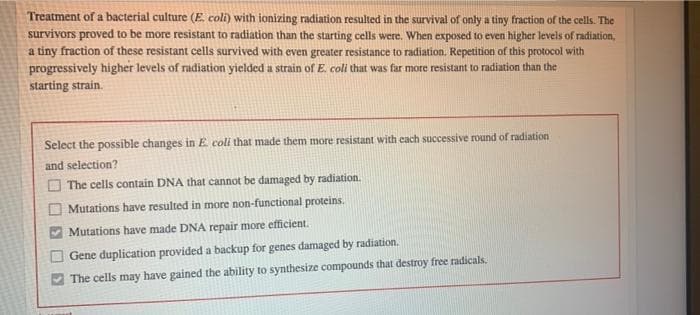a tiny fraction of these resistant cells survived with even greater resistance to radiation. Repetition of this protocol with progressively higher levels of radiation yielded a strain of E. coli that was far more resistant to radiation than the starting strain. Select the possible changes in E. coli that made them more resistant with each successive round of radiation and selection? The cells contain DNA that cannot be damaged by radiation. Mutations have resulted in more non-functional proteins. Mutations have made DNA repair more efficient. Gene duplication provided a backup for genes damaged by radiation. The cells may have gained the ability to synthesize compounds that destroy free radicals.
a tiny fraction of these resistant cells survived with even greater resistance to radiation. Repetition of this protocol with progressively higher levels of radiation yielded a strain of E. coli that was far more resistant to radiation than the starting strain. Select the possible changes in E. coli that made them more resistant with each successive round of radiation and selection? The cells contain DNA that cannot be damaged by radiation. Mutations have resulted in more non-functional proteins. Mutations have made DNA repair more efficient. Gene duplication provided a backup for genes damaged by radiation. The cells may have gained the ability to synthesize compounds that destroy free radicals.
Human Anatomy & Physiology (11th Edition)
11th Edition
ISBN:9780134580999
Author:Elaine N. Marieb, Katja N. Hoehn
Publisher:Elaine N. Marieb, Katja N. Hoehn
Chapter1: The Human Body: An Orientation
Section: Chapter Questions
Problem 1RQ: The correct sequence of levels forming the structural hierarchy is A. (a) organ, organ system,...
Related questions
Question
Give typing answer with explanation and conclusion

Transcribed Image Text:Treatment of a bacterial culture (E. coli) with ionizing radiation resulted in the survival of only a tiny fraction of the cells. The
survivors proved to be more resistant to radiation than the starting cells were. When exposed to even higher levels of radiation,
a tiny fraction of these resistant cells survived with even greater resistance to radiation. Repetition of this protocol with
progressively higher levels of radiation yielded a strain of E. coli that was far more resistant to radiation than the
starting strain.
Select the possible changes in E. coli that made them more resistant with each successive round of radiation
and selection?
The cells contain DNA that cannot be damaged by radiation.
Mutations have resulted in more non-functional proteins.
Mutations have made DNA repair more efficient..
Gene duplication provided a backup for genes damaged by radiation.
The cells may have gained the ability to synthesize compounds that destroy free radicals.
Expert Solution
This question has been solved!
Explore an expertly crafted, step-by-step solution for a thorough understanding of key concepts.
This is a popular solution!
Trending now
This is a popular solution!
Step by step
Solved in 4 steps

Knowledge Booster
Learn more about
Need a deep-dive on the concept behind this application? Look no further. Learn more about this topic, biology and related others by exploring similar questions and additional content below.Recommended textbooks for you

Human Anatomy & Physiology (11th Edition)
Biology
ISBN:
9780134580999
Author:
Elaine N. Marieb, Katja N. Hoehn
Publisher:
PEARSON

Biology 2e
Biology
ISBN:
9781947172517
Author:
Matthew Douglas, Jung Choi, Mary Ann Clark
Publisher:
OpenStax

Anatomy & Physiology
Biology
ISBN:
9781259398629
Author:
McKinley, Michael P., O'loughlin, Valerie Dean, Bidle, Theresa Stouter
Publisher:
Mcgraw Hill Education,

Human Anatomy & Physiology (11th Edition)
Biology
ISBN:
9780134580999
Author:
Elaine N. Marieb, Katja N. Hoehn
Publisher:
PEARSON

Biology 2e
Biology
ISBN:
9781947172517
Author:
Matthew Douglas, Jung Choi, Mary Ann Clark
Publisher:
OpenStax

Anatomy & Physiology
Biology
ISBN:
9781259398629
Author:
McKinley, Michael P., O'loughlin, Valerie Dean, Bidle, Theresa Stouter
Publisher:
Mcgraw Hill Education,

Molecular Biology of the Cell (Sixth Edition)
Biology
ISBN:
9780815344322
Author:
Bruce Alberts, Alexander D. Johnson, Julian Lewis, David Morgan, Martin Raff, Keith Roberts, Peter Walter
Publisher:
W. W. Norton & Company

Laboratory Manual For Human Anatomy & Physiology
Biology
ISBN:
9781260159363
Author:
Martin, Terry R., Prentice-craver, Cynthia
Publisher:
McGraw-Hill Publishing Co.

Inquiry Into Life (16th Edition)
Biology
ISBN:
9781260231700
Author:
Sylvia S. Mader, Michael Windelspecht
Publisher:
McGraw Hill Education